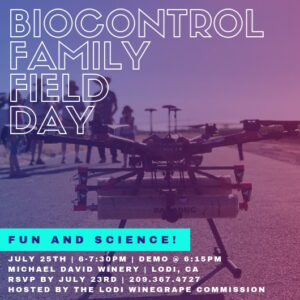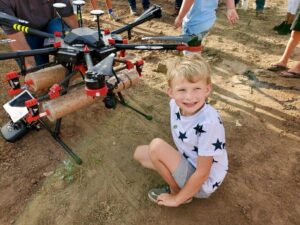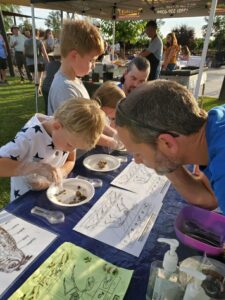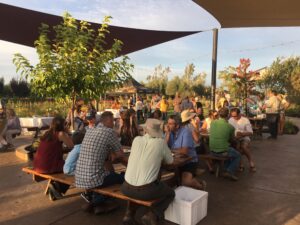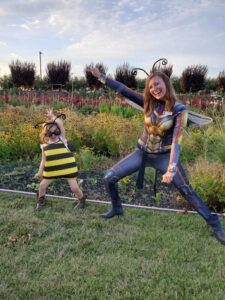Final report for OW19-351
Project Information
In agriculture, we constantly search for environmentally responsible pest management tools to reduce our reliance on synthetic plant protectants. Implementing natural biocontrol for insect pests is best practiced before resistance to insecticides develops. However, due to lack of experience and increased costs for materials and labor, producers are reluctant to experiment with biocontrol. Leafroll virus is infecting California grapevines at an alarming rate due to an aggressive insect vector, the vine mealybug. Leafroll virus infections reduce crop yield and quality, decrease a vineyard’s lifespan, and make the land less suitable for future grapevine plantings. In Lodi where we have 750 farmers and 100,000 acres of vineyards, it is imperative to demonstrate mealybug biocontrol. We conducted “A Collaborative Beneficial Insect and Pheromone Mating Disruption Demonstration Project” where a team of farmers practiced cooperative, regional mealybug biocontrol. Farmers used plant protectants which are safe for beneficials, beneficial insect releases, and applied a blanket of protective pheromone mating disruption across five vineyards. This team of early-adopter farmers set an example for Lodi by demonstrating the environmental, social, and economic benefits of cooperatively using biocontrol to manage a threatening disease. Our team hosted a “Family Field Day” in July 2019 where Lodi’s 750 farmers, local pest control advisors, the winemaking community and their children were invited to learn about collaborative pheromone mating disruption and participate in a drone beneficial insect release. The story behind the challenge of mealybugs and viruses, along with farmer experiences using biocontrol during this project, were explained in an outreach video called "Mealybug Biocontrol in California Vineyards." The video along with a blog post/newsletter article were distributed via the Lodi Winegrape Commission’s community of 1,000+ winegrowing professionals, and further advertised via Wine Business Monthly marketing channels. After learning about beneficial insects and pheromone mating disruption from this project, other farmers in Lodi continue to adopt biocontrol tools as part of regional and cooperative long-term mealybug and virus management.
Objectives:
- To demonstrate collaborative mealybug biocontrol efforts.
- To blanket five vineyards in mating disruption pheromone, reducing mealybug populations as measured by regular trapping and monitoring.
- To support and augment natural populations of beneficial insects which act as predators and parasites to the vine mealybug.
- To produce a fun and educational “Family Field Day” where farmers and their families learn about the importance of mealybug biocontrol.
- To produce and distribute a professional educational outreach video highlighting the challenges growers face while trying to manage vine mealybugs and leafroll virus, along with their collaborative biocontrol management strategy.
- To produce and distribute a blog post/newsletter article to 1000+ winegrowing community members about the project and what was learned.
November 2018
Grant Proposal is submitted
March 2019
Project team meets to discuss each individual farmer's plan for incorporating mealybug biocontrol into their practices.
April to November 2019
Regular trapping for vine mealybugs in the five project vineyards and one control (no biocontrol management) vineyard, to monitor the effectiveness of beneficial insect augmentation and pheromone mating disruption at controlling mealybug populations.
Approximately May to November 2019 (timing depends upon weather conditions for the vintage - will be advised by Dr. Daane) Pheromone mating disruption products are applied throughout entire growing season, through the fall.
Beneficial insects are supported and released.
Late summer 2019
Outreach: Family Field Day tailgate talk in a host vineyard and filming of the outreach video.
Evaluation: Farmers attending the Family Field Day will fill out the SARE survey.
April 2020
Debut of the outreach video at the Lodi Winegrape Commission's annual Mealybug and Virus Outreach Meeting. The video is also distributed via social media and our website.
A blog post/newsletter article is written and distributed.
Evaluation: Farmers attending the Mealybug and Virus Outreach Meeting will fill out the SARE survey.
Cooperators
- - Producer
- (Researcher)
- - Producer
- - Producer
- - Producer
- - Producer
Research
To demonstrate collaborative mealybug biocontrol efforts.
The Lodi Winegrape Commission has learned through experience that trying new management strategies is best done in a collaborative manner, where producers can work together in a grower-to-grower manner to figure out best application practices, generate discounts from purchasing in bulk, and ask each other for help as needed. The five growers were in regular communication with each other, the PI, and Dr. Kent Daane (our mealybug expert) during the project. They also shared their beneficial insect augmentation and pheromone mating disruption experiences with our broader community during our planned outreach, and they recorded all related expenses as well as the pros and cons of using these new management strategies.
To blanket five vineyards in mating disruption pheromone, reducing mealybug populations.
Five private, commercial vineyards were chosen to receive applications of pheromone mating disruption products. These mating disruption products come in the form of hanging tag dispensers, twist tie dispensers, and a flowable product which can be applied with a sprayer. Each producer chose the application method which made the most sense for their individual operation. Mealybug populations in these vineyards were regularly monitored during the growing season (April to November) using trapping for male mealybugs and visual scouting.
To support and augment natural populations of beneficial insects which act as predators and parasites to the vine mealybug.
At a preliminary meeting in March 2019, the farmers were asked to review their pesticide use plans for the upcoming growing season to ensure that they would not be spraying any pesticides which are harmful to mealybug parasites and predators. Producers also discussed the use of cover crops to provide habitat for beneficial insects. Based upon timing recommendations from Dr. Kent Daane, we coordinated bulk orders of beneficial insects (Anagyrus wasps and Cryptolaemus beetles) from Associates Insectary and BioBest, and released them in the five vineyards. Beetles were mainly released with the assistance of a drone via a company called parabug. The farmers and/or their pest control advisors scouted the vineyards for beneficial insects during the growing season during their normal pest monitoring, noting their presence or absence.
Collaboration increased adoption of biocontrol practices in our region and reduced overall cost of implementation.
Focused teams led by the PI, Dr. Stephanie Bolton, and some of this project's collaborators previously determined that adding the biocontrol practices of pheromone mating disruption and beneficial insects to an integrated pest management plan for vine mealybug and viruses was imperative for the Lodi winegrowing region. However, there were only a handful of farmers using pheromone mating disruption in Lodi at the start of this project in 2019. A main hurdle to adoption of this practice, which still exists today, is the increased short-term cost for mating disruption materials and labor. To overcome this hurdle, we assembled a team of influential local growers and pest control advisors to demonstrate the collaborative use of biocontrol for mealybug and virus management with great success.
Through collaboration, our project group was able to:
- educate each other on the best materials to use for mating disruption and how to access the needed materials and services,
- consult with Dr. Kent Daane and each other on timing and amount of application,
- share tips and results, and
- coordinate purchasing of beneficial insects and their drone release resulting in reduced overall cost.
Beneficial insects are reared by insectaries and must be shipped overnight, which can be quite expensive. Example cost for beneficial insects during project in 2019:
90,000 Cryptolaemus beetles (shipped in tubes of 500 beetles each) $7,200
CA Sales Tax $594.41
Shipping $245.74
TOTAL = $8,039.15 for 105.4 acres ($76.27 per acre)
Cooperator Mike Klouda coordinated timing with the other farmers and was able to provide parabug (the drone company) the map files for each property, so that the cost to release the beneficial insects by drone in one trip to Lodi on June 5, 2019, was reduced to $11 per acre. The price per acre for beetles and their application was $87.27.
Pheromone mating disruption applications significantly reduced mealybug trap counts.
It was already proven through multiple previous trials that pheromone mating disruption for vine mealybugs is able to shut down vine mealybug traps and reduce mating of vine mealybugs in the vineyard. In order to increase adoption of mating disruption, it is important for farmers to not only know these facts but also to experience a trap shutdown in their own vineyard firsthand. For a single farmer to go out and purchase vine mealybug traps, they would have to buy a minimum of 50 delta triangle traps and a minimum of 25 pheromone plugs to place inside the traps. During this project, Suterra (a mating disruption producer) was able to provide traps to the growers in the small numbers that were needed for this project (two traps per vineyard).
Only a few of the cooperating growers successfully used the traps and provided trap count data. There was some confusion. We learned that for future projects, there needs to be one designated person with a scientific background in charge of collecting data across all vineyards, and that trap placement (one trap near the edge of the vineyard and one trap near the center) matters.
Luckily for us, cooperator Charlie Starr IV took the experience gained during this project in 2019 and applied it to a larger-scale project in his sub-AVA with fellow grower Aaron Lange in 2020 - and he shared the data. Charlie and Aaron regularly trapped for vine mealybugs during the 2020 growing season (April - November) in 31 different vineyards. 14 vineyards used pheromone mating disruption for vine mealybug and 17 vineyards did not. The total counts for vine mealybugs found in traps during the growing season for each vineyard is displayed in Table 1 below. The mean of pheromone-treated block counts is 17 while the mean of control or non-mating disruption blocks is 628 mealybugs.
| Pheromone | Control |
| 2 | 542 |
| 6 | 672 |
| 102 | 386 |
| 4 | 113 |
| 0 | 74 |
| 56 | 32 |
| 18 | 536 |
| 16 | 535 |
| 6 | 348 |
| 21 | 1354 |
| 0 | 1249 |
| 0 | 291 |
| 4 | 634 |
| 2 | 735 |
| 2439 | |
| 632 | |
| 98 |
Table 1. Total vine mealybug counts from trapping in 31 vineyards (n=14 under pheromone mating disruption, "Pheromone" column, and n=17 under no mating disruption, "Control" column) during the 2020 growing season.
To determine whether there was a statistically significant difference between the mean total vine mealybug counts in the traps from the vineyards experiencing pheromone mating disruption (17, n=14) versus those without it (628, n=17), we ran an F-test and found that there was significantly more variance (p<0.001) in the control vineyards when compared with the vineyards under pheromone mating disruption. A t-test showed that the mean for total vine mealybug count per growing season under pheromone mating disruption (17) was significantly lower than the mean for total vine mealybug count per growing season without mating disruption (628), with a p-value less than 0.001. Considering that it only takes one vine mealybug to infect a grapevine with leafroll virus, this difference in means has a huge economic impact.
In conclusion, after experiencing pheromone mating disruption firsthand in 2019, cooperator Charlie Starr IV, with the help of other growers, was able to expand this practice into a neighborhood program to provide local data on the effectiveness of pheromone mating disruption for vine mealybug control. When growers practice cooperative pheromone mating disruption across an entire neighborhood or region, the overall population of mealybugs for that entire area is significantly reduced and there is more "bang for the buck", as we like to say.
Adoption of biocontrol practices for vine mealybug and grapevine virus management.
Each grower cooperator is still implementing a form of mealybug biocontrol in 2021. We've noticed that many more growers in the Lodi region are adopting pheromone mating disruption now that there is local data and farmers/PCAs with the knowledge needed to be successful in using it as part of an integrated pest management program. A key to this adoption in our region is that there are people whom farmers can call upon to ask about these practices. The video we created, "Mealybug Biocontrol in California Vineyards", has been viewed over 1,100 times as of April 2021.
Future directions.
Next, we are working to write a guide on best practices for vine mealybug mating disruption in the vineyards and later we plan to write a guide to organic vine mealybug management, which would include beneficial insect releases and mating disruption. Since price is still a major hurdle for grower adoption of mealybug biocontrol, we are working with agronomists and the California USDA NRCS to determine true costs for mating disruption implementation so that it can be considered for approval under programs such as EQIP and CSP.
Research outcomes
Education and Outreach
Participation summary:
COMPLETED ACTIVITIES
Consultations
Grant participants act as liaisons for mealybug biocontrol wisdom in our community - sharing their experiences with beneficial insects and pheromone mating disruption with other farmers in our region of 750 farmers and over 100,000 acres of vineyards.
Factsheets
We created an educational factsheet for the Michael David Winery beetle release/wine club tour event.
The Western IPM Center created a factsheet about our project too: Using Beneficial Insects to Combat Pests and Engage Growers,
Western SARE, July 2020.
On-farm demonstrations - Workshop / field days
On July 25, 2019, we hosted a Biocontrol Family Field Day - our main outreach event for this grant project. About 75 people attended, including farming families, winegrape buyers, winemakers, pest control advisors, the acting head of the California Department of Pesticide Regulations, the County Ag Commissioner, our local science museum, press, and others. The event was held in an operational vineyard owned by Michael David Winery, one of our grant partners. Heather Pyle opened the event with a description of the grant project, highlighting the importance of farmers working together to solve a difficult challenge like mealybugs and viruses. Then, Dr. Stephanie Bolton (dressed as a wasp superhero) performed a theatrical storytelling version of what biocontrol is and how it works (the science) for the Anagyrus wasp, the Cryptolaemus beetle, and the vine mealybug. Attendees were each given a vial of live Cryptolaemus beetles to either release by hand into the vineyard, to take home to their vineyard, or to load into the beneficial-insect releasing drone operated by a company called parabug (their choice). Most people loaded the beetles into the drone, which then performed a demo for us all, releasing beetles into the vineyard. Other entertainment included mealybug "juice", biocontrol-themed face painting, insect costumes, sustainable vineyard map coloring, and owl pellet dissections with the local science museum. It was an unforgettable event combining science, sustainability, education, and fun for all ages!
Some photos from the Biocontrol Family Field Day:
Published press articles/newsletters
- Lodi News Sentinel - https://www.lodinews.com/image_251d4bc2-b2ee-11e9-8be1-77f195cb006e.html
- A local news station came to the Biocontrol Family Field Day and we were on the news that evening
- Instagram:
Tours
Both Michael David Winery and Lucas Winery were able to time include their wine club members in a beetle release. They took wine club members out into the vines to teach them about the importance of biocontrol, letting them release beetles and explaining how the pheromone mating disruption tags work to reduce vine mealybug populations (and thus virus spread) without insecticides! According to David Lucas, the customers couldn't get enough.
Webinars, talks, and presentations
Taking lessons learned during the grant project and using the Biocontrol Family Field Day as an example, Dr. Stephanie Bolton gave a presentation called "Beneficial Insects - Sustainability Engagement" at the LODI RULES Sustainable Winegrowing Program's annual meeting in January 2020 to an audience of over 150 farmers and viticulture professionals.
The IPM Hour. “Engaging the Next Generation via Beneficial Insects: Sustainability, Biocontrol and Community Engagement.” July 13, 2020. Western IPM.
Dr. Stephanie Bolton also showed the outreach video, "Mealybug Biocontrol in California Vineyards" during her presentation at the Sustainable Ag Expo in November-December 2020. The presentation was called "Mealybug & Virus Management - New Resources Available from Lodi."
Outreach Video
We filmed video from the Biocontrol Family Field Day and interviewed 4 of the 5 participating growers in October 2019. We then interviewed the PI and edited this footage to produce a professional outreach video called "Mealybug Biocontrol in California Vineyards" which was shared via YouTube as a Premiere event on August 13, 2020. The video was also heavily advertised via Wine Business Monthly and our various email newsletters (reaching over 6,000 people), since we were not able to debut it at our annual Mealybug & Virus Meeting due to postponement from Covid-19. The video can be viewed here: https://www.youtube.com/watch?v=QF4hc1hS3-I.
Newsletter/blog articles
We published an article on our weekly viticulture blog at lodigrowers.com advertising the Biocontrol Family Field Day: https://www.lodigrowers.com/biocontrol-family-field-day-at-night/
We host a popular weekly viticulture blog on our Lodi Winegrape Commission website, lodigrowers.com, where we shared the story of the grant project and the outreach video: https://www.lodigrowers.com/mealybug-biocontrol-video-premiere-8-13/.
Suterra, an industry collaborator for this project, posted a blog when we released the outreach video: https://www.suterra.com/blog/vine-mealybug-biocontrol-in-vineyards.
Protected Harvest also posted a blog about this project and our outreach video: https://www.protectedharvest.org/vine-mealybug-biocontrol-in-vineyards-lodi-winegrape-commission-western-sare/.
Podcast
Plantopia Podcast, American Phytopathological Society. October 19, 2020. Episode 16. “For the Greater Good…of Wine.”
Education and Outreach Outcomes
Farmers, agricultural professionals, and our next generation of farmers gained awareness, knowledge, skills and more positive attitudes about the use of mealybug biocontrol in vineyards, including beneficial insects and pheromone mating disruption


